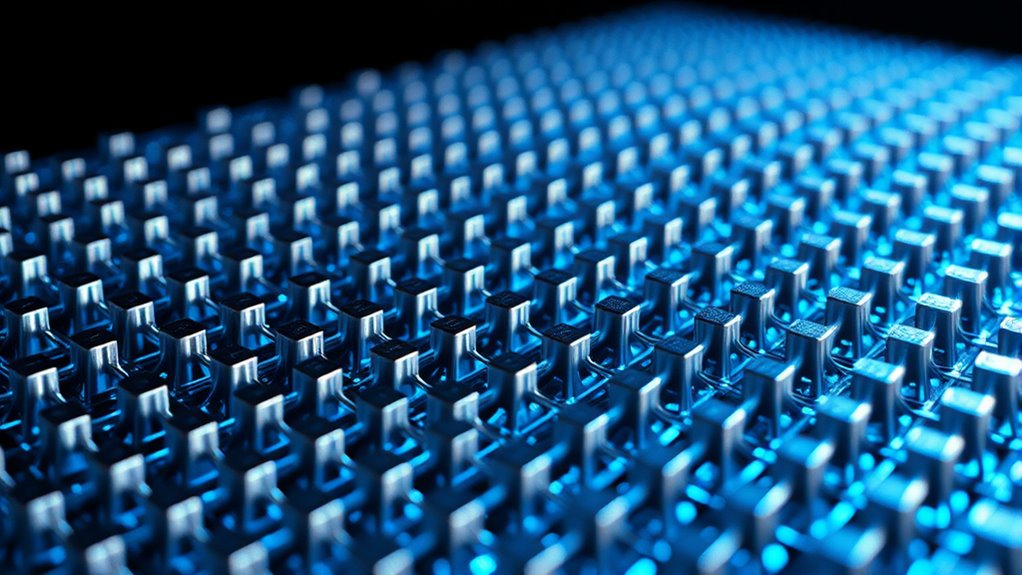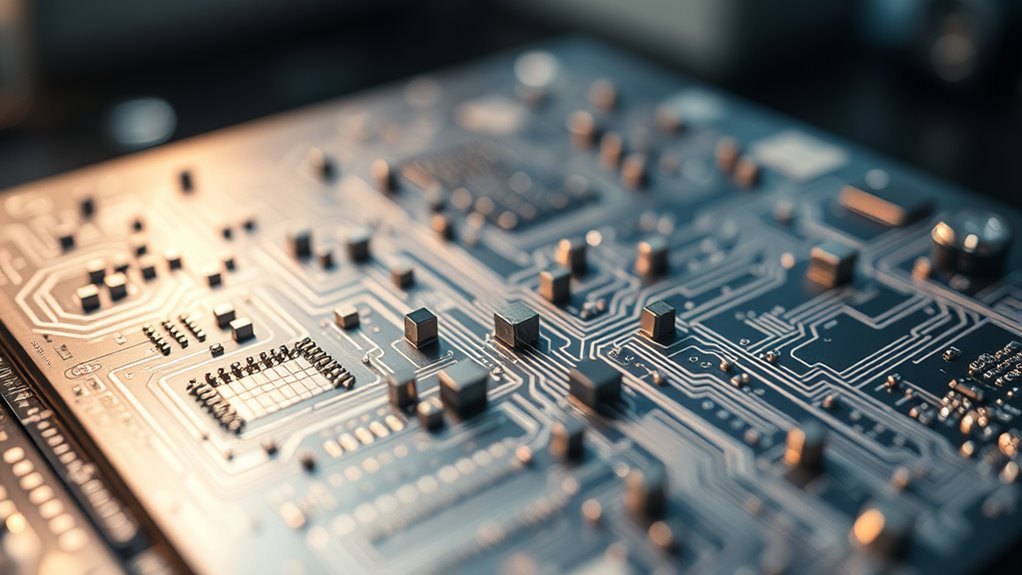Nanomagnets and spintronic devices utilize tiny magnetic structures and electron spins to create faster, more energy-efficient electronics. These technologies harness quantum effects, like spin states and tunneling, to improve data storage, processing, and security. Fabrication techniques enable precise control over magnetic properties, leading to miniaturized devices with enhanced performance. If you explore further, you’ll discover how these innovations are transforming industries and shaping future smart, sustainable technologies.
Key Takeaways
- Nanomagnets exhibit unique size-dependent magnetic properties, enabling miniaturized and high-performance spintronic devices.
- Electron spin manipulation in nanomagnets allows for faster, energy-efficient data storage and processing.
- Fabrication techniques like electron beam lithography and chemical vapor deposition are crucial for creating precise nanomagnets.
- Spintronic devices utilize electron spin states for non-volatile memory, offering advantages over traditional charge-based electronics.
- Advances in nanomagnet and spintronic technologies support sustainable electronics, secure data transfer, and quantum computing development.
Understanding the Fundamentals of Nanomagnets

To understand nanomagnets, it’s essential to grasp how their magnetic properties differ from those of bulk materials. When you reduce a material to the nanoscale, its magnetic behavior changes markedly. Nanomagnets are tiny, often just a few nanometers in size, so their magnetic domains are limited or even absent. This size restriction affects how magnetic moments align, leading to phenomena like superparamagnetism, where thermal energy can randomly flip magnetic directions. Unlike larger magnets, nanomagnets can switch their magnetic states more easily, which is key for applications in data storage and spintronics. Their unique properties stem from quantum effects and surface-to-volume ratio changes, making their behavior fundamentally different and more versatile than traditional, bulk magnetic materials. Additionally, the development of AI security measures plays a crucial role in protecting nanomagnetic and spintronic devices from cyber threats.
The Science Behind Electron Spin and Magnetic Moments

Electron spin is a fundamental quantum property that gives rise to magnetic moments in particles like electrons. You can think of spin as a tiny magnetic arrow within each electron, pointing in a particular direction. This intrinsic property results from quantum mechanics, meaning it doesn’t change like a classical object’s orientation. When many electrons align their spins, their magnetic moments combine, creating a magnetic field. This alignment underpins magnetic materials and spintronic devices. You don’t need to visualize the actual spinning of electrons; instead, understand spin as a quantum number that dictates magnetic behavior. The interaction between electron spins and external magnetic fields influences electronic properties, enabling your devices to store and manipulate data at the nanoscale efficiently. The concept of high magnetic susceptibility explains how these interactions can be harnessed in advanced technological applications. This fundamental science forms the backbone of modern spintronics.
Fabrication Techniques for Nanoscale Magnetic Materials

Fabricating nanoscale magnetic materials requires precise and advanced techniques that can manipulate matter at extremely small dimensions. You’ll often use methods like electron beam lithography, which employs focused electron beams to pattern nanostructures with high precision. Sputtering and chemical vapor deposition (CVD) are common for depositing thin magnetic films, allowing you to control thickness and composition accurately. Additionally, techniques like self-assembly enable you to organize magnetic nanoparticles into desired structures by exploiting natural chemical affinities. Focused ion beam (FIB) milling can carve or modify nanostructures directly. These methods demand careful calibration and clean environments to prevent defects. Mastery of these fabrication techniques is essential to create reliable nanomagnets for spintronic devices, ensuring they meet specific size, shape, and magnetic property requirements.
Key Properties of Nanomagnets and Their Applications

Nanomagnets exhibit unique magnetic properties that set them apart from their bulk counterparts, making them essential for advanced spintronic applications. Their small size results in high coercivity, enabling stable magnetic states. They also display superparamagnetism, allowing quick switching of magnetic orientation with minimal energy. Additionally, nanomagnets have a large surface-to-volume ratio, influencing magnetic anisotropy and interaction strength. These properties enable high-density memory storage, faster data processing, and energy-efficient devices. The table below summarizes key properties and their applications:
| Property | Description | Application |
|---|---|---|
| High coercivity | Resistance to demagnetization | Magnetic memory |
| Superparamagnetism | Rapid magnetic state switching | Magnetic sensors |
| Magnetic anisotropy | Direction-dependent magnetic behavior | Data stability in storage devices |
| Surface effects | Enhanced surface interactions influencing magnetism | Spintronic device efficiency |
| Size-dependent properties | Magnetic behavior varies with nanomagnet size | Tunable device characteristics |
Understanding magnetic anisotropy is crucial for designing stable and reliable spintronic devices.
How Spintronic Devices Differ From Traditional Electronics

Unlike traditional electronic devices that rely solely on the charge of electrons, spintronic devices harness the intrinsic spin of electrons to encode and process information. This fundamental difference allows spintronics to achieve higher speeds and lower power consumption. While conventional electronics manipulate voltage or current, spintronic devices utilize electron spin states, which can represent binary data more efficiently. This approach makes them more resistant to heat and electromagnetic interference, enhancing reliability. Additionally, spintronics enables non-volatile memory, meaning data remains stored even when power is off. By leveraging electron spin, these devices open new possibilities for faster, more durable, and energy-efficient electronic systems, setting them apart from traditional charge-based technologies. Understanding spintronic principles can further illuminate how these devices revolutionize modern electronics.
Innovations in Magnetic Memory Technologies

You’ll find that new magnetic memory technologies offer non-volatile storage, meaning your data stays intact even when powered off. Spintronic memory devices provide faster access times and lower energy consumption compared to traditional solutions. These innovations are transforming how we think about data storage and device performance.
Non-Volatile Storage Solutions
Have you ever wondered how modern electronics store data even when powered off? Non-volatile storage solutions make this possible by retaining information without continuous power. Magnetic memory technologies, like MRAM (Magnetoresistive Random Access Memory), use tiny magnetic elements called nanomagnets to hold data as magnetic states. These devices switch between magnetic orientations to represent ones and zeros, providing durable, high-speed, and energy-efficient storage. Unlike traditional volatile memory, non-volatile solutions don’t lose data during power outages. Innovations in magnetic materials and nanofabrication have considerably improved their stability and scalability. As a result, non-volatile storage is becoming essential in various applications, from portable devices to large-scale data centers, ensuring your data remains safe, accessible, and ready whenever you need it. Total-cost clarity about manufacturing and operation costs further supports their adoption.
Spintronic Memory Advantages
Advances in spintronic memory technologies have revealed significant advantages over traditional magnetic storage methods. You benefit from faster read and write speeds, enabling more responsive devices. Spintronic memories are also highly energy-efficient because they consume less power during operation, reducing overall energy costs. Their non-volatile nature means data stays intact without power, enhancing reliability and reducing data loss risks. Additionally, spintronic devices have greater durability since they resist wear and mechanical degradation better than conventional storage media. This combination of speed, efficiency, and durability allows for more compact, reliable, and sustainable memory solutions. The diverse applications of spintronic memory are expanding across various electronic devices, highlighting its versatility and potential for future innovations. As a result, spintronic memories are poised to revolutionize data storage, enabling smarter, faster, and more energy-conscious electronic devices.
Quantum Effects in Spin-Based Devices

Quantum tunneling allows electrons to pass through energy barriers in spintronic devices, affecting their stability and performance. Spin entanglement opens new possibilities for secure communication and quantum computing applications. Understanding these effects is key to advancing next-generation nanomagnetic technologies. Additionally, advancements in Honda Tuning have demonstrated how precise modifications can optimize performance, which parallels the importance of understanding quantum effects for device enhancement.
Quantum Tunneling Phenomena
Quantum tunneling plays a crucial role in spin-based devices by allowing magnetic moments to flip or switch states without overcoming energy barriers through thermal activation. Instead of relying on heat to overcome energy differences, particles tunnel directly through barriers, enabling faster and more efficient switching. This phenomenon becomes significant at the nanoscale, where energy barriers are comparable to quantum fluctuations. Tunneling influences the stability and coherence of magnetic states, impacting device performance. In spintronic applications, it can cause unintended magnetization reversals, challenging data retention. Conversely, it offers opportunities for ultra-fast switching and low-energy operations. Understanding quantum tunneling helps you design devices that either leverage or mitigate these effects, ensuring more reliable and scalable spin-based technologies. This quantum behavior fundamentally shapes the future of nanomagnetism. Recognizing the role of quantum effects is essential for advancing spintronic device performance and stability.
Spin Entanglement Applications
Spin entanglement offers powerful opportunities in spin-based devices by enabling particles to share correlated states regardless of distance. This phenomenon can improve quantum communication, enhance sensor sensitivity, and enable secure data transfer. For example, entangled spins in nanomagnets can serve as qubits, forming the basis for quantum computing. These applications rely on maintaining coherence and controlling entanglement over practical scales. To visualize this, consider the following table:
| Spin State | Entangled Partner | Potential Application |
|---|---|---|
| Spin Up | Spin Down | Quantum key distribution |
| Spin Left | Spin Right | Spintronic logic circuits |
| Spin Zero | Spin Zero | Quantum sensors |
Additionally, material properties play a crucial role in optimizing entanglement stability and device performance.
Challenges in Developing Reliable Spintronic Systems

Developing reliable spintronic systems faces several significant challenges that hinder their widespread adoption. One major obstacle is maintaining stable spin states over time, as thermal fluctuations can cause spin decoherence and data loss. Variability in material quality further complicates consistent device performance, making large-scale manufacturing difficult. Additionally, integrating spintronic components with existing electronic systems requires overcoming compatibility issues, such as differing voltage and current requirements. Precise control of spin injection and detection remains complex, often leading to inefficiencies. Energy consumption is another concern; achieving low-power operation without sacrificing performance is essential for practical applications. Finally, scaling devices down to nanometer dimensions introduces fabrication challenges, affecting reliability and uniformity across devices. Addressing these issues is crucial to transition spintronics from research to real-world, commercial technologies, especially as AI security solutions increasingly rely on advanced hardware for data protection.
Future Directions and Potential Breakthroughs

Emerging materials and innovative techniques promise to push spintronics into new domains of performance. You’ll see potential in integrating nanomagnets with quantum computing, opening doors for faster, more efficient systems. Exploring these frontiers could lead to breakthroughs that transform how we process and store information.
Emerging Materials and Techniques
What new materials and techniques could revolutionize the future of nanomagnetism and spintronic devices? Researchers are exploring two-dimensional materials like graphene and transition metal dichalcogenides, which offer exceptional electronic and magnetic properties at nanoscale. These materials enable faster, more energy-efficient devices by facilitating spin transport with minimal loss. Additionally, advances in topological insulators provide robust spin currents protected from scattering, opening new possibilities for stable spintronic applications. Techniques like ultrafast laser manipulation and strain engineering allow precise control over magnetic states, boosting device performance. Combining these emerging materials with innovative fabrication methods could lead to breakthroughs in data storage, logic devices, and neuromorphic computing, pushing the boundaries of what’s achievable in nanomagnetism and spintronics.
Integration With Quantum Computing
Could nanomagnets and spintronic devices hold the key to next-generation quantum computing? They offer promising pathways for qubit development, thanks to their stability and potential for rapid switching. By leveraging magnetic states and electron spin, you can encode quantum information with high coherence times, reducing error rates. Integrating these materials with existing quantum systems might enable scalable architectures that operate at higher speeds and lower energy costs. Spintronics could also facilitate more efficient readout and control mechanisms, essential for practical quantum processors. Although challenges remain in coherence preservation and device fabrication, progress in nanomagnet design and material engineering signals a future where spintronic elements enhance quantum computing capabilities considerably. This integration could revolutionize how you process and store information at the quantum level.
Impact of Nanomagnet and Spintronic Technologies on Society

Nanomagnet and spintronic technologies are transforming society by enabling faster, more energy-efficient electronic devices. You’ll notice these advancements in everyday gadgets like smartphones, computers, and data storage systems, which now operate with greater speed and lower power consumption. These innovations also promote sustainability by reducing energy demands and extending device lifespans. Additionally, they open new possibilities for secure data transfer and innovative computing architectures, impacting industries such as healthcare, finance, and transportation. As these technologies become more widespread, they’ll create jobs, foster economic growth, and enhance technological capabilities worldwide. You’ll benefit from smarter, more reliable devices that improve your daily life while helping address global energy and environmental challenges. The societal impact is profound, shaping a more connected, efficient future.
Frequently Asked Questions
How Do Temperature Fluctuations Affect Nanomagnet Stability?
Temperature fluctuations can considerably impact nanomagnet stability by causing thermal agitation that disrupts magnetic alignment. As temperature rises, the energy barrier maintaining the magnetic state decreases, making it easier for the nanomagnet to switch or lose its magnetization. This instability can lead to data loss or device malfunction. To guarantee reliable operation, you need to manage temperature carefully, often through cooling or material engineering, to keep stability intact.
What Are the Environmental Impacts of Spintronic Device Manufacturing?
You might not realize, but manufacturing spintronic devices consumes significant energy—up to 50% more than traditional electronics. This process can generate hazardous waste, including toxic chemicals and heavy metals, which threaten ecosystems and human health. Additionally, mining rare materials like cobalt and rare earth elements causes habitat destruction and pollution. These environmental impacts highlight the importance of developing greener manufacturing methods to minimize your device’s ecological footprint.
Can Nanomagnets Be Integrated With Biological Systems?
Yes, nanomagnets can be integrated with biological systems. You can functionalize their surfaces with biomolecules, allowing them to target specific cells or tissues. Their small size enables you to manipulate and track them within the body using magnetic fields. This integration opens opportunities for medical imaging, targeted drug delivery, and biosensing. However, you should consider potential toxicity and biocompatibility issues to guarantee safe and effective applications in biological environments.
What Are the Cost Implications of Scaling Spintronic Technologies?
Scaling spintronic technologies can be costly, but the potential savings are significant. You might face initial high investment for research, manufacturing, and infrastructure, potentially costing billions. However, as production ramps up and economies of scale kick in, costs could drop by up to 50%. This means you’ll see faster, more energy-efficient devices, making it a worthwhile investment despite the hefty upfront expenses.
How Do Quantum Effects Influence Data Retention in Nanomagnetic Memory?
Quantum effects can disrupt data retention in nanomagnetic memory by causing spontaneous flips of magnetic states through tunneling or superposition. You might notice that as the size of the magnetic elements shrinks, these effects become more pronounced, making it harder to maintain stable data over time. To counteract this, you need to carefully design your devices with materials and structures that minimize quantum interference, ensuring reliable long-term storage.
Conclusion
As you explore nanomagnets and spintronic devices, imagine revealing a hidden universe where electrons dance like celestial bodies, revolutionizing technology. These tiny magnets hold the key to faster, smarter electronics that could reshape society’s future. Though challenges remain, your curiosity fuels breakthroughs on the horizon. Embrace this frontier, where science’s brush paints a vibrant landscape of innovation, transforming everyday life into a symphony of magnetic marvels.









